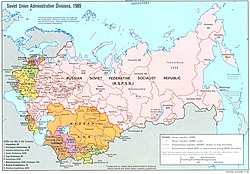Atlas of the Soviet Union
Initially spared from significant difficulties following the Bolshevik Revolution that created the USSR, state-sponsored persecution against the Bahá'ís began in earnest in 1928, culminating in the banning of Bahá'í meetings, the dissolution of Spiritual Assemblies, the expropriation of the House of Worship in Ashkhabad, the exile of prominent Bahá'ís to gulags in Siberia, and the deportation of many Persian Bahá'ís to Iran.[4] By 1938, the activities of the Bahá’í community had ground to a halt.[3] Only a handful of groups remained across the USSR, with some isolated individuals scattered across the Union. Bahá'ís were noted as living in "no more than five" Soviet Republics by 1953: the Azerbaijan, Armenian, Georgian, Turkmen, and Uzbek SSRs.[2]
Some limited expansion took place during the Ten Year Crusade, when additional Bahá'ís arrived in the Kazakh, Kirghiz, and Tajik Republics. After slow progress through the 1960s and early 1970s, the late 1970s saw a new phase of growth, beginning with the Byelorussian SSR welcoming its first pioneer, which was followed by the first Bahá'í wedding recorded in the USSR.[2] A wave of new pioneers arrived in Moscow and a number of other cities across the Union. Finally, with the openness brought by the new government policy of glasnost, organized groups began to enter in the late 1980s, introducing Soviet citizens to the Bahá'í Faith on a large scale and sparking rapid growth. In February 1990, the Soviet Union's first Bahá'í conference in 60 years took place, gathering followers from 35 different centres; at Ridvan that year, Local Spiritual Assemblies were formed in Moscow, Yuzhno-Sakhalinsk, Kiev, and Tallinn, joining the Ashkhabad Assembly which had reformed the previous year. The following year, enough centres had been established to elect the first—and last—National Spiritual Assembly of the Soviet Union, shortly before the Union's dissolution on December 31, 1991. Five National Spiritual Assemblies were formed in 1992, including an independent Assembly in Azerbaijan and four joint Assemblies which were gradually replaced by independent Assemblies for the rest of the former Soviet Republics.
National Assembly: Soviet UnionOfficial Website: http://www.bahaisofiran.org/
Statistics
Population:
Bahá’í pop.: 300,000 [5]
History
First Local Assembly: 1895, Ashkhabad
First National Assembly: 1991
First National Convention: 1990
Regions of the Soviet Union[edit]
General areas[edit]
The largest constituent republic of the Soviet Union was the Russian SFSR, roughly coterminous with the modern-day Russian Federation. Within the Russian SFSR, the following regions are defined:
-
European Russia: Territory west of the Ural Mountains
-
Siberia: Territory east of the Ural Mountains
-
Russian Far East: Between Lake Baikal and the Pacific Ocean
The following three general areas of the Soviet Union can also be highlighted:
-
Eastern Europe: Estonian, Latvian, Lithuanian, Byelorussian, Ukrainian, and Moldavian SSRs
-
The Caucasus: Georgian, Armenian, and Azerbaijan SSRs
-
Central Asia (Turkestan): Kazakh, Uzbek, Turkmen, Kirghiz, and Tajik SSRs
Soviet Republics[edit]
Demography[edit]
Population[edit]
-
Population density (1982)
Language, ethnicity, and religion[edit]
-
Ethnic groups (1970s)
-
Religious groups (1961)
-
Religious groups (1981)
History[edit]
Background[edit]
Formation of the USSR and early years[edit]
In the years immediately following the Bolshevik revolution, the Bahá’í community was largely spared from the harsh anti-religious laws enacted by the new government and for a time enjoyed considerable freedom.[6] At the time, major centres of Bahá’í activity existed in three areas of the Soviet Union, including European Russia (Moscow, St. Petersburg), the Caucasus (Baku, Yerevan, Tbilisi), and Turkestan (Ashkhabad, Samarkand, Tashkent).[7]
Isolation[edit]
Reawakening[edit]
Dissolution of the USSR[edit]
Media[edit]
| A collection of media related to the Soviet Union Events (Conferences • Conventions (Nat'l) • Establishments • Holy days • Publications • Seasonal schools (Summer • Winter)) |
Notes and references[edit]
|
General remarks
Notes References
|
Entries available in the atlas[edit]
Table Of Contents
-
1.1 Regions of the Soviet Union
-
1.1.2 General areas
-
1.2.3 Soviet Republics
-
1.1.2 General areas
-
2.4 Demography
-
2.1.5 Population
-
2.2.6 Language, ethnicity, and religion
-
2.1.5 Population
-
3.7 History
-
3.1.8 Background
-
3.2.9 Formation of the USSR and early years
-
3.3.10 Isolation
-
3.4.11 Reawakening
-
3.5.12 Dissolution of the USSR
-
3.1.8 Background
-
4.13 Media
-
5.T-1 Notes and references
-
6.T-2 Entries available in the atlas










